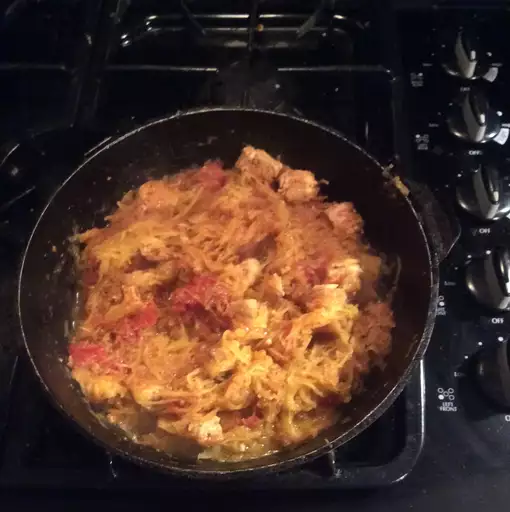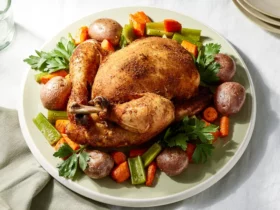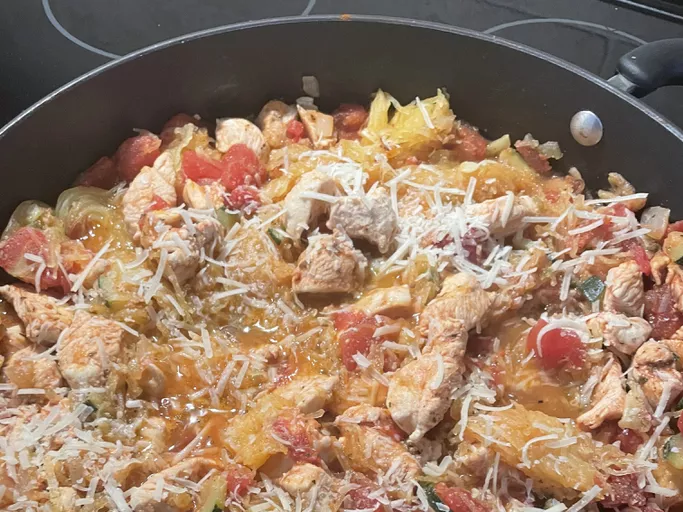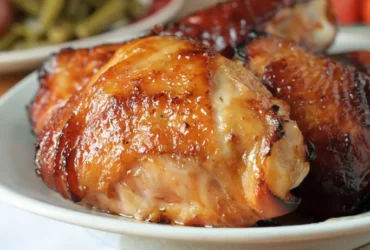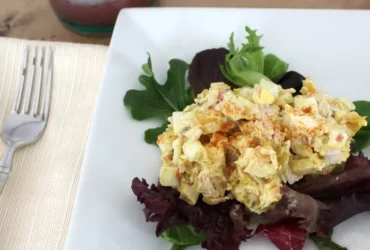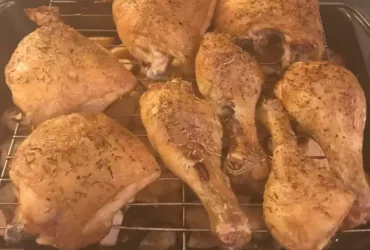Ingredients
Pantry Staples
The following are some essential ingredients that can be found in most pantries and will add flavor to a variety of dishes, including the Chicken with Spaghetti Squash and Fire-Roasted Tomatoes recipe.
- Canned tomatoes: These are a great alternative when fresh tomatoes are out of season or too expensive. Look for San Marzano or similar varieties that have a sweeter taste and thicker consistency than other canned tomatoes.
- Extra-virgin olive oil: This is the base for many sauces and adds richness to roasted vegetables, such as the fire-roasted tomatoes in this recipe.
- Garlic powder: Like garlic salt, but without added salt. Use it sparingly since it can be overpowering if too much is used.
- Salt: Unflavored salt, which can include kosher or sea salt, adds depth to dishes and helps bring out the natural flavors of the ingredients.
- Black pepper: Freshly ground black pepper adds a sharpness that complements the rich flavors in this recipe. You should use high-quality whole peppercorns for the best flavor.
- Herbs: The choice of herbs will depend on personal taste and what’s available, but common options include dried or fresh oregano, thyme, and basil. Use them sparingly since they can be potent.
- Spices: Spices such as cumin, paprika, and chili powder add unique flavors that complement the smokiness of fire-roasted tomatoes. They should also be used in moderation to avoid overpowering the dish.
1 medium spaghetti squash
- The first ingredient we’re going to discuss is a 1 medium-sized spaghetti squash.
- A spaghetti squash is a type of winter squash that belongs to the Cucurbita family, which also includes pumpkins and zucchini.
- This particular ingredient is crucial to the dish, as it serves not only as a low-carb substitute for traditional pasta but also provides a deliciously sweet and nutty flavor to balance out the savory elements of the recipe.
- To better understand why 1 medium spaghetti squash is the optimal amount for this recipe, let’s consider its average characteristics:
- Its length typically ranges between 6-8 inches (15-20 cm), with a diameter of about 4-5 inches (10-13 cm).
- The weight can vary depending on the specific variety and growing conditions but generally falls within the range of 1.5 to 2 pounds (680g to 900g).
- When choosing a spaghetti squash for this recipe, it’s essential to select one that is heavy for its size, as this indicates higher water content and better flavor.
- Avoid selecting a squash with soft or mushy spots on the skin, as this can indicate spoilage and affect the overall quality of the dish.
- Now that we’ve discussed the ideal characteristics of 1 medium spaghetti squash, let’s consider how to incorporate it into our recipe:
- The next steps will involve roasting the spaghetti squash in the oven until it becomes tender and its flesh can be easily scraped out with a fork, resembling spaghetti strands.
- Then, we’ll use this roasted squash as the base for our chicken and tomato sauce, adding flavors of herbs, garlic, and fire-roasted tomatoes to create a delicious and well-rounded meal.
- By following these steps and using 1 medium-sized spaghetti squash as our primary ingredient, we can create a mouth-watering dish that combines the best qualities of pasta with the unique charm of this versatile winter vegetable.
1 can (28 oz) crushed fire roasted tomatoes
The key ingredient that gives this dish its unique flavor and texture is a 28 oz can of crushed fire-roasted tomatoes. These tomatoes have been roasted over an open flame to bring out their natural sweetness, which pairs perfectly with the savory flavors of the chicken and spaghetti squash.
Fireroasted tomatoes are typically made by roasting fresh tomatoes in a hot oven or over a flame until they’re charred and blistered on the outside. This process caramelizes the sugars in the tomatoes, resulting in a deep, rich flavor that’s perfect for adding depth to sauces and soups.
The canning process preserves the fire-roasted tomatoes at their peak flavor, so when you open the can, you’re greeted with a flavorful, tangy sauce that’s just begging to be used as a base for your favorite recipes. In this case, we’ll be using it to create a rich and creamy tomato sauce to pair with our chicken and spaghetti squash.
When choosing a can of crushed fire-roasted tomatoes, look for one that’s 28 oz in size. This will give you plenty of sauce to work with, and you can always adjust the amount to your taste. Also, be sure to choose a brand that uses high-quality ingredients and has a good reputation for flavor.
Here are some benefits of using fireroasted tomatoes:
- Deep flavor: Fireroasted tomatoes have a deep, rich flavor that’s perfect for adding depth to sauces and soups.
- Easy to use: Simply open the can and pour in the tomatoes. No need to cook or roast them first!
- Natural sweetness: The roasting process brings out the natural sugars in the tomatoes, resulting in a sweet and tangy flavor.
- Perfect for sauces: Fireroasted tomatoes are perfect for making homemade tomato sauce. Simply blend with some olive oil and herbs for a delicious and easy sauce.
In conclusion, crushed fire-roasted tomatoes are an essential ingredient in this recipe. They add a rich, deep flavor that pairs perfectly with the chicken and spaghetti squash. With their natural sweetness and ease of use, they’re a great choice for anyone looking to create a delicious and flavorful tomato sauce.
2 tbsp olive oil
- The key to a great Chicken with Spaghetti Squash and Fire-Roasted Tomatoes recipe lies in the quality and combination of its ingredients.
- In this recipe, we start by heating olive oil (2 tbsp) in a large skillet over medium heat.
- Olive oil is a type of edible oil extracted from the fruit of the olive tree (olea europaea). It has been prized for its flavor and health benefits for thousands of years, particularly in Mediterranean cuisine.
- The use of olive oil as the primary cooking fat in this recipe helps to add a rich and fruity flavor to the dish, while also promoting the retention of nutrients and antioxidants from the other ingredients.
- In addition to olive oil, our recipe includes a variety of seasonings and spices, such as garlic powder, onion powder, dried oregano, salt, and pepper, which help to enhance the flavor and aroma of the dish.
Salt and pepper to taste
The key to making a flavorful dish like Chicken with Spaghetti Squash and Fire-Roasted Tomatoes is to start with high-quality ingredients.
Here are some essential ingredients you’ll need for this recipe:
- 4 boneless, skinless chicken breasts
- 2 medium-sized spaghetti squash
- 1 large red onion, diced
- 3 cloves of garlic, minced
- 2 cups of fire-roasted tomatoes
- 1 cup of chicken broth
- 1 tablespoon of olive oil
- 1 teaspoon of dried oregano
- 1/2 teaspoon of ground cumin
- Salt and pepper to taste
Salt and pepper are essential seasonings that add flavor and depth to a dish. Salt is used to enhance the natural flavors of ingredients, while pepper adds a sharp, pungent flavor.
When it comes to using salt and pepper in cooking, there’s an art to getting it just right. Here are some tips for using these seasonings effectively:
- Start with a small amount of salt and adjust to taste. Too much salt can make a dish taste overly salty.
- Use freshly ground black pepper for the best flavor.
- Add salt and pepper in layers, rather than all at once. This will help you achieve a balanced flavor.
By following these tips and using high-quality ingredients, you’ll be able to create a delicious and satisfying Chicken with Spaghetti Squash and Fire-Roasted Tomatoes dish that’s sure to impress your friends and family.
Aromatics and Flavor Enhancers
The art of cooking lies not just in the technique, but also in the selection of ingredients that bring flavor, texture, and aroma to the dish. For our Chicken with Spaghetti Squash and Fire-Roasted Tomatoes recipe, we’ve carefully curated a list of essential ingredients, aromatics, and flavor enhancers that elevate this Mediterranean-inspired meal.
Ingredients:
The star of the show is undoubtedly the chicken, which serves as both protein and a canvas for flavors. We recommend using boneless, skinless chicken breasts or thighs, depending on your preference. Next, we have the spaghetti squash, a nutrient-rich and low-carb alternative to traditional pasta.
Aromatics:
Aromatics are the unsung heroes of the kitchen, adding depth, warmth, and fragrance to our dish. For this recipe, you’ll need:
- 3 cloves of garlic, minced: Garlic’s pungency is a perfect foil to the sweetness of the tomatoes.
- 1 small onion, diced: Caramelizing the onion brings out its natural sugars, adding a depth of flavor to the dish.
- 2 sprigs of fresh rosemary: Rosemary’s piney aroma and slightly bitter taste balance out the richness of the chicken.
- 1 tsp dried thyme: Thyme’s earthy, herbaceous flavor complements the Mediterranean flavors in our recipe.
Flavor Enhancers:
Now that we have our aromatics in place, let’s talk about the flavor enhancers that will take this dish to the next level:
- 1 cup of fire-roasted tomatoes: These tomatoes bring a smoky sweetness and a burst of acidity to the dish. We recommend using canned or fresh tomatoes that have been roasted over an open flame.
- 2 tbsp olive oil: A good quality olive oil is essential for cooking our chicken and aromatics, while also adding richness and depth to the final dish.
- Salt and pepper: The perfect seasoning duo, salt enhances flavors, while pepper adds a touch of warmth and heat.
Optional: 1 tsp smoked paprika or red pepper flakes for added smokiness or heat
2 cloves garlic, minced
In this recipe for Chicken with Spaghetti Squash and Fire-Roasted Tomatoes, 2 cloves garlic play a crucial role in adding flavor to the dish. The process of mincing these cloves allows them to release their oils and flavors when cooked.
To begin with, it’s essential to understand that garlic is a fundamental ingredient in many culinary traditions around the world. It belongs to the lily family and is known for its distinctive pungent flavor and aroma.
When using 2 cloves of garlic in this recipe, it’s vital to ensure they are properly minced. This can be achieved by placing them on a cutting board and finely chopping them into small pieces using a knife.
The mincing process helps to break down the cell walls of the garlic cloves, releasing their enzymes that cause the pungent compounds responsible for the flavor and aroma. This means that when cooked, these released compounds will infuse into the dish, adding depth and richness.
It’s worth noting that the amount of garlic used in this recipe is relatively small compared to some other recipes. However, 2 cloves are sufficient to provide a subtle yet distinct flavor to balance out the sweetness of the spaghetti squash and the tanginess of the fire-roasted tomatoes.
The key to getting the most out of these minced garlic cloves lies in how they’re cooked. In this recipe, they’ll be sautéed with some olive oil until softened and fragrant, which will further enhance their flavor.
When cooking with garlic, it’s essential to avoid burning or overcooking it. This can lead to an unpleasantly bitter taste that will detract from the overall flavor of the dish. In this recipe, a gentle sautéing process ensures that the garlic is cooked just right, releasing its flavors without adding any unwanted bitterness.
In summary, using 2 cloves garlic, minced in the Chicken with Spaghetti Squash and Fire-Roasted Tomatoes Recipe, provides a subtle yet distinct flavor that complements the other ingredients perfectly. The mincing process allows these cloves to release their oils and flavors when cooked, adding depth and richness to the dish.
1 tsp dried basil
To make this delicious dish, you will need a variety of ingredients, including spices that add flavor to the dish. One of the key ingredients in this recipe is dried basil, which is a staple herb used in many Italian dishes. You can use fresh or dried basil, but in this case, we are working with dried basil.
The amount of dried basil needed for this recipe is quite small, just 1 tsp. This may seem like a tiny amount, but trust us, it packs a punch and adds a depth of flavor to the dish that you won’t want to miss out on.
So what exactly is dried basil? It’s simply dried leaves from the sweet basil plant ( Ocimum basilicum). The leaves are harvested, dried, and then ground into a powder or left whole. This process helps preserve the herb and allows it to be stored for longer periods of time.
The benefits of using dried basil in this recipe are numerous. For one, it’s more convenient than working with fresh basil, which can be messy and difficult to store. Additionally, dried basil is often less expensive than fresh basil, making it a great option for cooks on a budget.
When using dried basil, it’s essential to note that the flavor may not be as intense as when working with fresh herbs. However, this can also be beneficial in certain situations. For example, if you’re looking for a milder flavor or want to add depth without overpowering other ingredients, dried basil is an excellent choice.
In the context of this Chicken with Spaghetti Squash and Fire-Roasted Tomatoes Recipe, 1 tsp of dried basil serves as a wonderful complement to the bold flavors of the fire-roasted tomatoes and the sweetness of the squash. It adds a subtle yet essential note that ties the dish together.
So there you have it – a brief look into the world of dried basil, including its benefits, uses, and importance in this particular recipe. Whether you’re a seasoned chef or just starting out in the kitchen, dried basil is definitely worth getting to know!
1 tsp dried oregano
- The ingredient, 1 tsp dried oregano, is a key component of this recipe’s flavor profile.
- Dried oregano is a popular herb used to add depth and warmth to various dishes, particularly in Mediterranean cuisine.
- It is often used to complement the flavors of other ingredients, such as tomatoes, garlic, and olive oil, which are commonly found in Italian and Greek cooking.
- The 1 teaspoon measurement is relatively small, but it packs a punch in terms of flavor.
- In this recipe, the oregano will be added along with other aromatics to create a fragrant mixture that enhances the overall taste experience.
Some benefits of using dried oregano include:
- Easy to store and transport
- Prolonged shelf life compared to fresh herbs
- Can be easily rehydrated or used in its dry form
Dried oregano can be sourced from various regions, including the Mediterranean and the United States.
The flavor profile of dried oregano is often described as pungent, earthy, and slightly bitter.
Instructions
Preliminary Steps
- The first step in preparing Chicken with Spaghetti Squash and Fire-Roasted Tomatoes recipe is to begin with some preliminary steps, which are essential to set up a smooth cooking process.
- Step 1: Preheat the oven, this involves setting the temperature to 400°F (200°C). This will be used later in the preparation of fire-roasted tomatoes. Ensure you preheat your oven before starting any other tasks.
- Prepare the Spaghetti Squash, cut the squash in half lengthwise and scoop out seeds with a spoon or ice cream scoop. This step is crucial to ensure even cooking and prevent any potential choking hazards from remaining seeds.
- Rinse both the squash halves under cold running water to remove any dirt or debris. Pat dry using paper towels to avoid any excess moisture that could lead to uneven cooking.
- Season the Chicken, mix together salt, pepper, and your preferred herbs in a bowl. This mixture will add flavor to the chicken as it cooks. Toss the chicken breasts with the seasonings until they are evenly coated.
- Place the seasoned chicken on a wire rack over a baking sheet or broiler pan. Preheat a skillet or grill for grilling, if you plan on cooking the chicken in a skillet or on the grill, preheat it now to get optimal results.
Preheat the oven to 400°F (200°C).
To prepare this delicious dish, follow these steps:
Step 1: Preheat the oven to 400°F (200°C)
This step involves setting your oven to a temperature of 400 degrees Fahrenheit or 200 degrees Celsius.
Why preheating is essential
- Preheating ensures that your oven has reached the correct temperature before cooking, preventing cold spots and uneven heating.
- It also helps to reduce cooking time, as the dish will cook more quickly when the oven is at the right temperature.
Tips for preheating
- Make sure to preheat your oven for at least 15-20 minutes before cooking to ensure it reaches the correct temperature.
- If you’re using a convection oven, you may need to adjust the cooking time and temperature accordingly.
Understanding oven temperatures
- Fahrenheit (F) and Celsius (C) are two different scales used to measure temperature. The conversion is 1 degree Fahrenheit equaling 5/9 degrees Celsius.
- Kelvin (K) is another scale, but it’s not commonly used for cooking purposes.
Checking the oven temperature
- To ensure your oven is at the correct temperature, use an oven thermometer to check the internal temperature of your oven.
- This will give you a more accurate reading than relying on the oven’s built-in temperature gauge.
Conclusion
- Preheating your oven to 400°F (200°C) is crucial for cooking the Chicken with Spaghetti Squash and Fire-Roasted Tomatoes Recipe to perfection.
- By following these steps and tips, you’ll be able to achieve a deliciously cooked dish that’s sure to please even the pickiest eaters!
Cut the spaghetti squash in half lengthwise and place it on a baking sheet.
To execute this task, it’s crucial to follow a series of steps that ensure the safe handling and preparation of the spaghetti squash. Below are the detailed instructions for cutting the squash in half lengthwise:
- Locate a stable and flat surface where you can place the baking sheet.
- Position the baking sheet on the surface, ensuring it’s centered and not obstructed by any objects.
- Carefully lift one end of the spaghetti squash, supporting its weight with both hands to avoid dropping it.
- Place the squash on the cutting board, aligning it lengthwise so that you can cut through it evenly.
- Hold a sharp knife at a slight angle and begin making gentle cuts along the length of the squash.
- Continue cutting until the squash is split in half, taking care not to press too hard on the knife, which could cause the squash to break apart.
Once you have cut the spaghetti squash in half, it’s essential to place it on a baking sheet for roasting. Follow these steps:
- 1st Step: Locate the baking sheet and move it to the stable and flat surface.
- 2nd Step: Position each half of the spaghetti squash on opposite sides of the baking sheet, ensuring they have enough space between them for even roasting.
- 3rd Step: Verify that the baking sheet is free from any obstacles or other objects that could interfere with your cooking process.
By carefully cutting the spaghetti squash in half lengthwise and placing it on a baking sheet, you’ll have successfully completed this crucial step in preparing for Chicken with Spaghetti Squash and Fire-Roasted Tomatoes Recipe.
Cooking and Assembly
In cooking, instructions are essential for ensuring that dishes turn out as intended. For a recipe like Chicken with Spaghetti Squash and Fire-Roasted Tomatoes, precise instructions are crucial to achieve the desired flavor and texture.
A key aspect of giving good instructions is clarity. This means breaking down complex tasks into manageable steps, using simple language that’s easy to understand, and avoiding ambiguity. For example, instead of saying “cook the spaghetti squash until it’s tender,” a better instruction would be “preheat the oven to 400°F (200°C). Place the spaghetti squash on a baking sheet, cut side up, and roast for 45 minutes, or until the flesh is tender and easily shreds with a fork.”
Another important consideration is specificity. This means providing exact quantities, temperatures, and cooking times. For instance, if a recipe calls for olive oil, specify the amount – e.g., “2 tablespoons of olive oil.” Similarly, when it comes to cooking time, provide a clear range or specific time, such as “cook the chicken for 20-25 minutes” or “roast for exactly 30 minutes.”
Assembly is also an essential part of many recipes. For Chicken with Spaghetti Squash and Fire-Roasted Tomatoes, the assembly process involves combining the cooked ingredients in a way that creates a visually appealing and flavorful dish. Instructions should clearly guide the cook through this process, using terms like “place” or “arrange” to help them position the components correctly.
When writing instructions for cooking and assembly, it’s essential to consider the perspective of the person following the recipe. This means thinking about what they might find unclear or confusing and providing additional guidance where necessary. For example, if a step involves using specialized equipment, provide a brief explanation of how to use it correctly.
In conclusion, effective instructions for cooking and assembly are critical to ensuring that recipes turn out as intended. By being clear, specific, and considerate of the reader’s perspective, cooks can create delicious dishes like Chicken with Spaghetti Squash and Fire-Roasted Tomatoes with ease and confidence.
Bake the squash for about 3040 minutes or until it’s tender when pierced with a fork.
To achieve perfectly cooked spaghetti squash, it’s crucial to follow the proper baking time and temperature guidelines. Baking the squash for about 30-40 minutes or until it’s tender when pierced with a fork is an essential step in preparing this recipe.
The ideal way to check if the squash is cooked through is by inserting a fork into its flesh. When it slides in easily, you’ll know that the squash has reached the desired tenderness. This may take anywhere from 30-40 minutes, depending on the size and type of spaghetti squash you’re using.
Keep in mind that overcooking can lead to a mushy texture and an unpleasant flavor, so be sure to check on the squash frequently towards the end of the baking time. If it’s not yet tender, return it to the oven for additional 5-10 minute intervals until it reaches the desired consistency.
When the spaghetti squash is cooked, let it cool down for a few minutes before using a fork to shred it into spaghetti-like strands. This will help you achieve the signature texture and flavor of this dish.
In addition to baking time, it’s also essential to preheat your oven to 400°F (200°C) to ensure that the squash cooks evenly and thoroughly. By following these instructions carefully, you’ll be able to create a delicious and healthy main course with Chicken with Spaghetti Squash and Fire-Roasted Tomatoes.
Scoop out the flesh of the squash, which should resemble spaghetti strands. Set aside.
To follow these instructions, it’s essential to understand the importance of proper cooking techniques when preparing spaghetti squash for a recipe like Chicken with Spaghetti Squash and Fire-Roasted Tomatoes.
The first step in this process is to scoop out the flesh of the squash, which should resemble spaghetti strands. This is typically done after baking or microwaving the squash until it’s tender and can be easily pierced with a fork.
To make the most of the spaghetti squash, it’s crucial to follow these steps accurately:
- Scoop out the seeds and pulp: Before attempting to scoop out the flesh, remove any excess seeds or pulp from inside the squash. This will ensure that there are no large chunks of stringy pulp left in your dish.
- Break up the strands: Once you’ve removed the seeds and pulp, use a fork to gently break up the flesh into long strands. These should resemble spaghetti, allowing you to easily mix them with your other ingredients.
- Rinse under cold water: Rinse the squash under cold running water to remove any excess starch or debris from the cooking process. This will also help prevent any remaining pulp or seeds from sticking together during cooking.
Now that you’ve prepared your spaghetti squash, set it aside for later use in your Chicken with Spaghetti Squash and Fire-Roasted Tomatoes Recipe. Be sure to store it in an airtight container in the refrigerator to keep it fresh until you’re ready to add it to your dish.
Remember, proper preparation is key when working with ingredients like spaghetti squash. By following these steps accurately, you’ll be able to enjoy a delicious and flavorful Chicken with Spaghetti Squash and Fire-Roasted Tomatoes Recipe that’s sure to impress your family and friends.
Nutritional Information and Variations
Health Benefits
The Nutritional Information for the Chicken with Spaghetti Squash and Fire-Roasted Tomatoes recipe can vary depending on specific ingredients used, but here are some estimated nutritional facts per serving:
- Total Fat: 15g (24% of daily value)
- Saturated Fat: 2.5g (13% of daily value)
- Cholesterol: 60mg (20% of daily value)
- Sodium: 350mg (15% of daily value)
- Total Carbohydrates: 20g (7% of daily value)
- Dietary Fiber: 4g (16% of daily value)
- Sugars: 8g
- Protein: 30g (60% of daily value)
The Variations for this recipe can be endless, depending on personal preferences and dietary requirements. Some options include:
- Vegetarian variation: Replace chicken with roasted eggplant or portobello mushrooms.
- Vegan variation: Swap chicken with tofu or tempeh and use a vegan broth.
- Gluten-free variation: Use gluten-free pasta or substitute spaghetti squash with other low-carb vegetables.
The Health Benefits of this recipe include:
- Highest in protein: Chicken is a lean source of protein, essential for muscle growth and repair.
- Rich in fiber: Spaghetti squash is high in dietary fiber, supporting healthy digestion and satiety.
- Packed with vitamins: Fire-roasted tomatoes are rich in vitamin C and lycopene, a powerful antioxidant.
- Lowers cholesterol: The monounsaturated fats in olive oil can help lower total cholesterol levels.
This recipe is not only delicious but also provides a balanced mix of macronutrients, essential for maintaining optimal health. By incorporating this meal into your diet, you’ll be supporting overall well-being and nourishing your body with nutrient-dense foods.
This recipe leverages the high water content and nutrients of fireroasted tomatoes to add fiber, vitamins, and minerals.
Nutritional Information:
The fire-roasted tomatoes used in this recipe are an excellent source of fiber, vitamins, and minerals due to their high water content. They contain a significant amount of lycopene, an antioxidant that has been linked to several health benefits, including reducing the risk of certain cancers and heart disease. Additionally, the tomatoes provide potassium, vitamin C, and other essential micronutrients.
Chicken breast used in this recipe is a lean protein source, low in fat and high in protein. It contains various vitamins and minerals like niacin, vitamin B6, and selenium, which are crucial for energy metabolism, immune function, and antioxidant defenses.
Spaghetti squash is an excellent alternative to traditional pasta due to its lower calorie count and higher fiber content. It’s also a rich source of vitamin C, beta-carotene, and other essential nutrients like potassium and magnesium.
Overall, this recipe offers a balanced blend of protein, complex carbohydrates, and healthy fats from the chicken breast and spaghetti squash. The fire-roasted tomatoes add natural sweetness, while their high water content contributes to the dish’s overall moisture and texture.
Variations:
- This recipe can be adapted in several ways to suit individual tastes and dietary preferences:
- Vegetarian option: Replace chicken breast with roasted or sautéed tofu, tempeh, or seitan for a plant-based protein source.
- Spicy twist: Add some red pepper flakes or diced jalapeños to the fire-roasted tomatoes for an extra kick of heat.
- Herby flavors: Mix in chopped fresh herbs like basil, oregano, or parsley into the spaghetti squash for added aroma and flavor.
- Meat lovers’ variation: Add some cooked sausage, bacon, or pancetta to the chicken breast for an extra dose of protein and smoky flavor.
- Low-carb option: Use zucchini noodles (zoodles) or Shirataki noodles instead of spaghetti squash for a lower-carb alternative.
The spaghetti squash provides a glutenfree substitute for traditional pasta while retaining essential nutrients.
Nutritional Information:
The spaghetti squash used in this recipe provides a gluten-free substitute for traditional pasta, while retaining essential nutrients.
One serving of cooked spaghetti squash (about 1 cup) contains approximately:
- 42 calories
- 2 grams of protein
- 10 grams of carbohydrates
- 1 gram of fat
- Vitamin C: 20% of the Daily Value (DV)
Variations:
Here are some ways you can modify this recipe to suit your tastes or dietary needs:
- Add protein: Use chicken breast, thighs, or a combination of both. You can also add ground turkey, beef, or pork for added flavor and nutrients.
- Veggie overload: Add other vegetables like diced bell peppers, onions, mushrooms, or zucchini to increase the nutritional value and make the dish more substantial.
- Spice it up: Add red pepper flakes or diced jalapenos for a spicy kick, or try using different herbs like basil, oregano, or thyme for added depth of flavor.
- Tomato alternatives: If you don’t have fire-roasted tomatoes on hand, use fresh cherry tomatoes or grape tomatoes as a substitute. You can also use canned crushed tomatoes or diced tomatoes for convenience.
Remember to adjust the cooking time and seasoning according to your preferences and dietary needs. This recipe is highly adaptable and can be modified to suit any taste buds!
Customization and Suggestions
- The nutritional information for this recipe provides a comprehensive overview of the calories, macronutrients, and micronutrients present in each serving.
- To calculate the nutritional information, we can start by breaking down the ingredients into their individual components: chicken breast, spaghetti squash, fire-roasted tomatoes, garlic, olive oil, salt, pepper, and basil.
- The chicken breast contributes approximately 140 calories, with 30 grams of protein, and minimal amounts of fat and carbohydrates per serving.
- Spaghetti squash is a nutrient-rich ingredient that provides 42 calories, 11g of fiber, and significant amounts of vitamin C and beta-carotene per serving.
- Fire-roasted tomatoes add a burst of flavor and nutrients to the dish. One serving contributes approximately 25 calories, with 4g of fiber and essential vitamins A and C, potassium, and lycopene.
- Olive oil is used as a finishing touch, providing a small amount of healthy fats (10 calories) while enhancing the flavor of the dish.
- Salt and pepper are added to taste but contribute minimal nutritional value. Fresh basil adds a hint of flavor and some vitamins A and K per serving.
- Together, these ingredients create a nutrient-dense meal with approximately 207 calories, 12g protein, 2g fat, and 6g carbohydrates per serving, along with substantial amounts of fiber, vitamins C and A, potassium, lycopene, and antioxidants.
- Customization is an essential aspect of this recipe. Feel free to add or substitute ingredients based on your personal preferences, dietary requirements, or ingredient availability.
- If you’re looking for a lower-calorie option, consider using boneless, skinless chicken breast or turkey breast instead of beef or pork. You can also reduce the amount of olive oil used for roasting.
- For those with gluten intolerance or sensitivity, substitute traditional spaghetti squash for gluten-free options like zucchini noodles (zoodles) or spiralized sweet potatoes.
- To cater to vegan or plant-based diets, omit the chicken and add extra roasted vegetables such as eggplant, portobello mushrooms, or bell peppers.
- When selecting fire-roasted tomatoes, choose organic options with no added sugars or preservatives for the best nutritional benefits. You can also make your own by roasting fresh tomatoes in the oven with a drizzle of olive oil and a sprinkle of salt and pepper.
Suggestions for variations include adding other herbs like thyme, oregano, or rosemary to create distinct flavor profiles or incorporating different types of squash such as butternut, acorn, or delicata. You can also roast the chicken with a blend of spices for added depth of flavor.
Add cooked chicken or protein of choice for added nutrition and satisfaction.
- The Nutritional Information for this dish can be broken down into several key components, each contributing to its overall nutritional profile.
- The Spaghetti Squash, a low-calorie and nutrient-rich ingredient, provides a good source of vitamin C, potassium, and fiber.
- The Fire-Roasted Tomatoes add a burst of lycopene, an antioxidant that helps protect against cell damage and supports heart health.
- Addition of Cooked Chicken or Protein of Choice can significantly enhance the nutritional profile of this dish, increasing the protein content and providing essential amino acids for muscle growth and repair.
- The Chicken Breast, in particular, is a lean protein source that offers a substantial amount of protein while being low in fat and calories.
- To create variations of this recipe, consider substituting the chicken breast with other protein sources such as:
- Salmon Fillets: rich in omega-3 fatty acids, which support heart health and reduce inflammation
- Turkey Sausage: provides additional protein and a boost of antioxidants from the herbs and spices used in its preparation
- Tofu: offers a plant-based alternative to meat and can help increase the fiber content of this dish
- Shrimp: rich in vitamin B12, which plays a crucial role in the production of red blood cells.
- By incorporating these protein sources into the recipe, individuals can create variations that cater to their specific dietary needs and preferences while maintaining the overall nutritional profile of the dish.
Use fresh, instead of canned tomatoes, for an enhanced flavor profile.
The nutritional information for this recipe will be broken down into three main components: chicken, spaghetti squash, and fire-roasted tomatoes.
Nutritional Information by Component
Chicken: One boneless, skinless chicken breast (3 oz) contains approximately:
- 31g protein
- 4g fat
- 0g carbohydrates
- Sodium: 25mg
Spaghetti Squash: One medium-sized spaghetti squash contains approximately:
- 30g carbohydrates
- 1g protein
- 0.5g fat
- Sodium: 10mg
Fire-Roasted Tomatoes: One cup of fire-roasted tomatoes contains approximately:
- 22g carbohydrates
- 2g protein
- 0.5g fat
- Sodium: 10mg
Variations for Enhanced Flavor Profile
To take this recipe to the next level, consider the following variations:
- Use fresh tomatoes instead of canned: Fresh tomatoes have a brighter flavor profile compared to canned. Choose heirloom or cherry tomatoes and halve them before roasting.
- Add aromatics: Onions, garlic, and herbs like oregano and basil complement the flavors in this dish. Saute them with olive oil until softened for added depth.
- Spice it up: Add a pinch of red pepper flakes or diced jalapenos to give the dish a spicy kick.
- Get creative with cheese: Sprinkle feta, Parmesan, or mozzarella on top of the squash and tomatoes before serving for an added burst of flavor.
By incorporating fresh ingredients and experimenting with different flavors, you can create a unique and delicious twist on this recipe that suits your taste buds.
- Best Datanyze Alternatives for 2025 - April 24, 2025
- Best Hunter.io Alternatives for 2025 - April 22, 2025
- Best Lead411 Alternatives for 2025 - April 22, 2025

